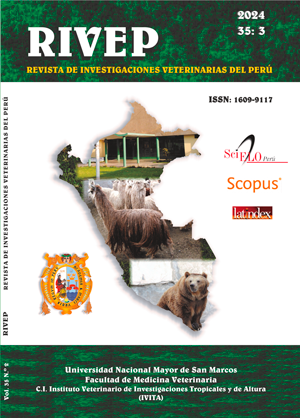Parasitic stages in vegetables marketed in Chiclayo, Peru
DOI:
https://doi.org/10.15381/rivep.v35i3.26131Keywords:
vegetable, market, contamination, parasitic stage, public healthAbstract
The risk of infection by parasitic agents in contaminated vegetables is greater when the characteristics of the sale stalls in markets and the hygiene of street vendors is poor. This study aimed to determine the prevalence of parasitic stages and identify the genera/species found in vegetables sold in the main markets of the city of Chiclayo, Peru. In total, 600 vegetable samples were analysed, 75 for each species: lettuce, green onion, celery, radish, cabbage, coriander, parsley and spinach. Using wet mounting, it was determined that 51% (95%CI 47-55) of the samples contained parasitic stages. Entamoeba spp, Giardia spp, Balantidium coli, Taenia spp, Enterobius vermicularis, Ascaris spp, Trichuris spp, Toxocara spp, and Hymenolepis nana were identified. The proportion of protozoan cysts/oocysts was higher than helminth eggs. Lettuce and green onion were the vegetables with the highest presence of parasitic stages. It is concluded that the vegetables sold in the main districts of Chiclayo are highly contaminated with parasitic stages.
Downloads
Downloads
Published
Issue
Section
License
Copyright (c) 2024 César Morante Chavarry, Luis Vargas-Rocha, Severino Torrel-Pajares

This work is licensed under a Creative Commons Attribution 4.0 International License.
AUTHORS RETAIN THEIR RIGHTS:
a. Authors retain their trade mark rights and patent, and also on any process or procedure described in the article.
b. Authors retain their right to share, copy, distribute, perform and publicly communicate their article (eg, to place their article in an institutional repository or publish it in a book), with an acknowledgment of its initial publication in the Revista de Investigaciones Veterinarias del Perú (RIVEP).
c. Authors retain theirs right to make a subsequent publication of their work, to use the article or any part thereof (eg a compilation of his papers, lecture notes, thesis, or a book), always indicating the source of publication (the originator of the work, journal, volume, number and date).



